inflation pressure AUDI Q5 2015 Owners Manual
[x] Cancel search | Manufacturer: AUDI, Model Year: 2015, Model line: Q5, Model: AUDI Q5 2015Pages: 302, PDF Size: 75.01 MB
Page 143 of 302
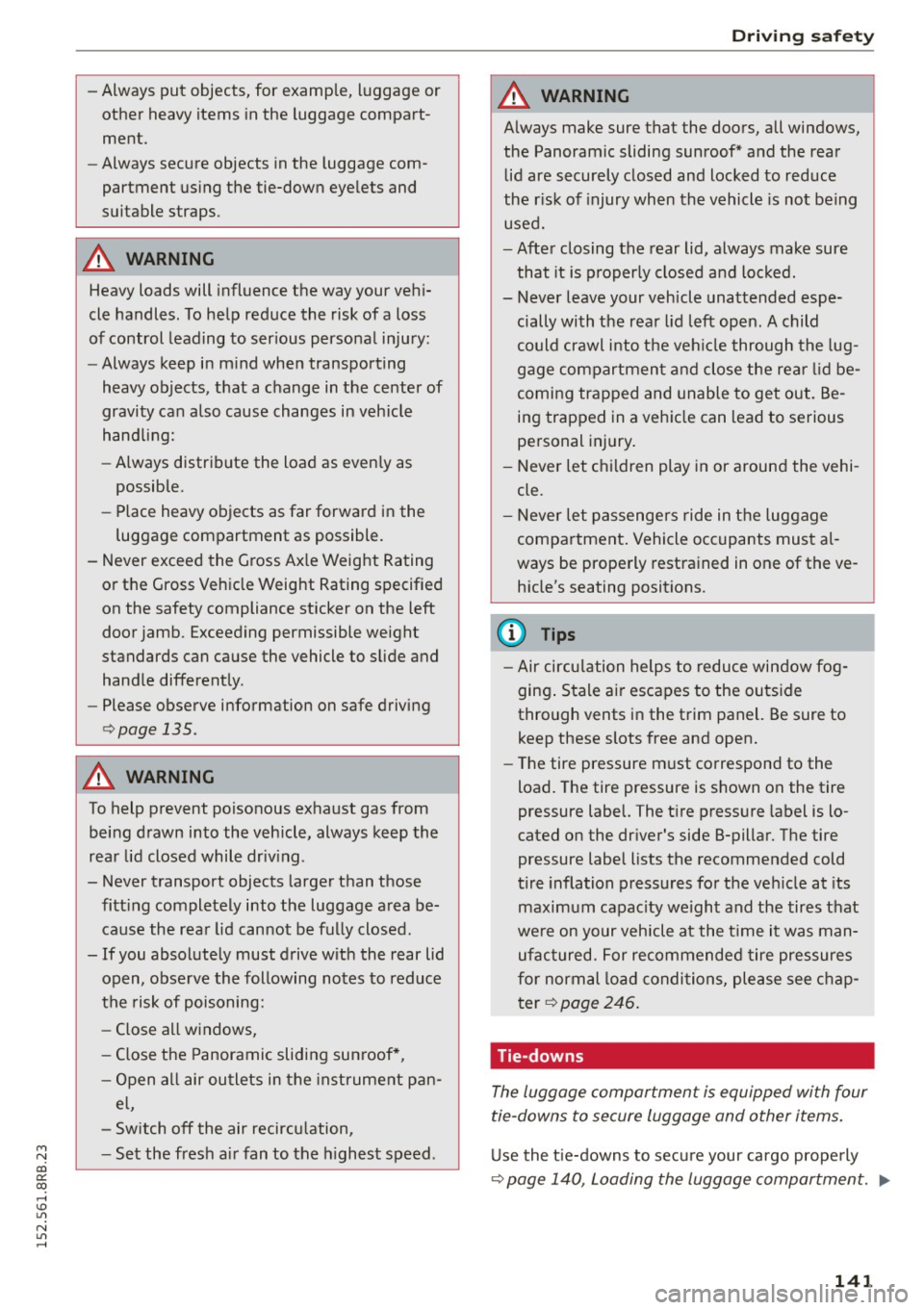
M N
co
a:
co
,...., \!) 1.1'1
N 1.1'1 ,....,
-Always put objects, for examp le, luggage or
other heavy items in the luggage c ompart
ment.
- Always secure objects in the luggage com
partment us ing the tie-down eye lets and
suitable straps.
A WARNING
Heavy loads will influence the way your vehi
cle handles. To help reduce the risk of a loss
of control leading to ser ious personal injury:
- Always keep in m ind when transporting
heavy objects, that a change in the center of
gravity can also cause changes in vehicle
hand ling:
- Always distribute the load as even ly as
possible.
- Place heavy objects as far forward in the
luggage compartment as possible.
- Never exceed the G ross Ax le Weight Rating
or the Gross Vehicle Weight Rating specified
on the safety compliance sticker on the left
doo r jamb. Exceeding permissible weight
standards can cause the vehicle to s lide and
hand le different ly.
- Please observe information on safe driving
r=>page 135.
A WARNING
To help prevent poisonous exhaust gas from
being drawn into the vehicle, always keep the
rear lid closed while driv ing.
- Never transport objects larger than those
fitt ing completely into the luggage a rea be
cause the rea r lid cannot be fully closed .
- If you absolutely must drive w ith the rear lid
open, observe the following notes to reduce
the risk of poisoning:
- Close a ll windows,
- Close the Panoramic sliding sunroof*,
- Open al l air outlets in the instrument pan-
el,
- Sw itch off the air recircu lation,
- Set the fresh ai r fan to the h ighest speed.
Dr ivin g s afet y
A WARNING
Always make sure that the doors, all windows,
the Panoramic sliding sunroof * and the rear
lid are securely closed and locked to reduce
the r is k of injury when the vehicle is not being
used.
- After closing the rear lid, always make sure
that it is p roperly closed and locked.
- Never leave your vehicle unattended espe
cially with the rea r lid left open . A child
could crawl into the ve hicle through the lug
g age compartmen t and clo se the re ar lid be
coming trapped and unable to get out. Be
ing trapped in a vehicle can lead to serious
pe rsonal injury .
- Never let children play in or around the vehi
cle.
- Never let passengers ride in the luggage
compa rtment . Vehicle occupants must al
ways be properly restrained in one of the ve
hicle's seating positions.
(D Tips
- Air circul ation helps to reduce window fog
ging . Stale ai r escapes to the outs ide
through vents in the t rim panel. Be sure to
keep these slots free and open.
- The tire pressure m ust correspond to the
load. The tire pressure is shown on the tire
pressure label. The t ire p ress ure label is lo
cated on the dr iver's side B-pillar. The tire
pressure label lists the recommended cold
t ire inflation pressures fo r the veh icle at its
maximum ca pac ity weight and the tires that
we re on your vehicle at the t ime it was man
ufac tured. For recommended tire pressures
for normal load condi tions, please see chap
ter
r=> page 246.
Tie-downs
The luggage compar tment is equipped wi th four
tie-downs to se cure luggage and other items .
Use the t ie-downs to secu re your cargo prope rly
r=> page 140, Loading the luggage compar tment. lliJ,
141
Page 239 of 302
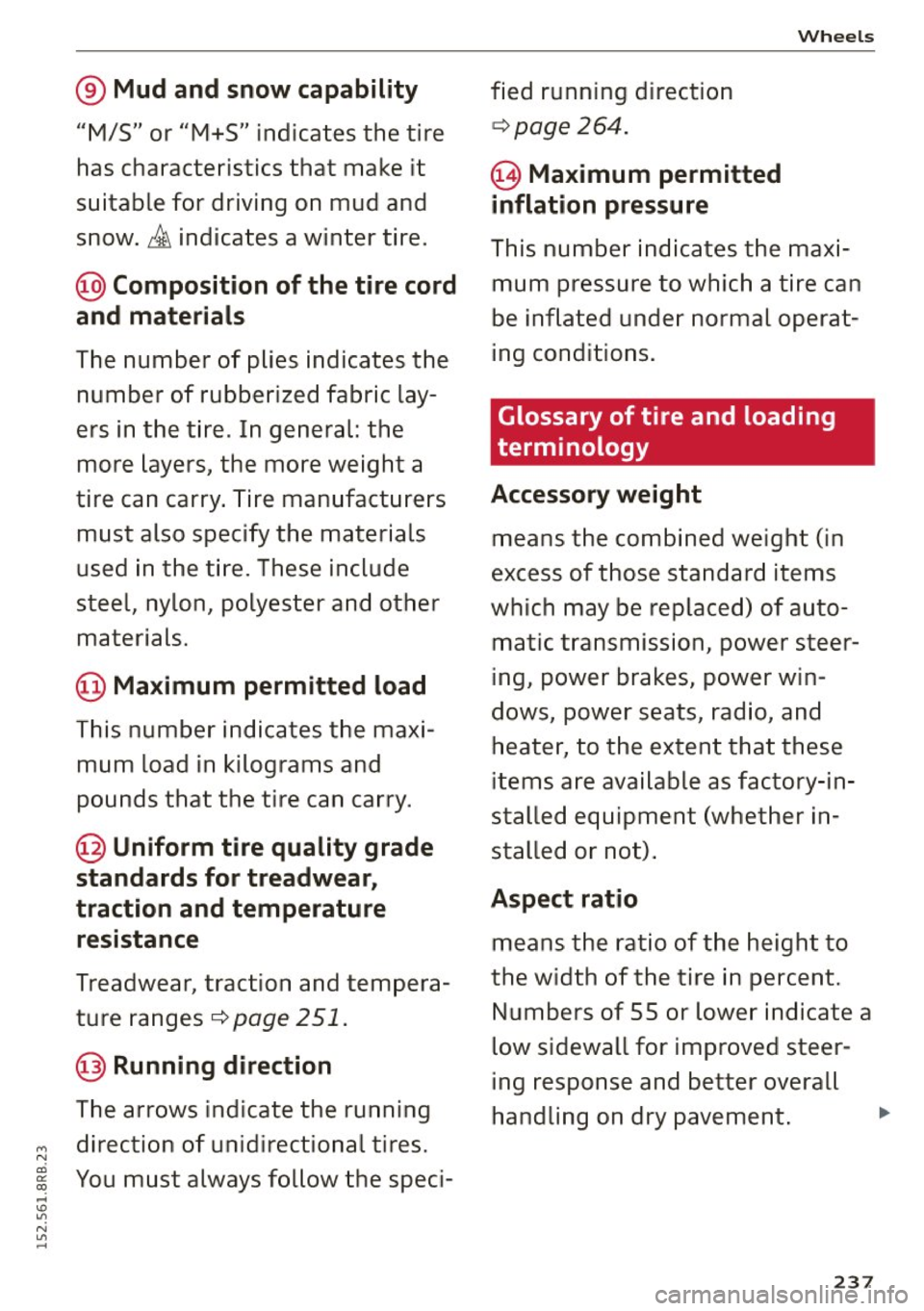
® Mud and snow capability
"M/S" or "M+S" indicates the tire
has characte ris tics that make it
suitable for driving on mud and snow .
& indica tes a winter tire.
@ Composition of the tire cord
and materials
T he number of plies indicates the
number of rubber ized fabric lay
ers in the tire . In general: the
more layers, the more weight a
tire can carry. Tire manufacturers
must also specify the mater ials
used in the ti re. These include
stee l, nylon, polyester and other
materials.
@ Maximum permitted load
This number indicates the maxi
mum load in kilograms and
pounds that the tire can carry .
@ Uniform tire quality grade
standards for treadwear,
traction and temperature resistance
Treadwear , traction and tempera
ture ranges
c::::> page 251 .
@Running direction
The arrows ind icate the running
direction of unidirect ional tires.
You must always follow the speci- fied running direction
c::::> page 264.
€3) Ma
ximum permitted
inflation pressure
Whe els
This number indicates the maxi
mum pressure to which a tire can
be inflated unde r normal operat
ing conditions .
Glossary of tire and loading
terminology
Accessory weight
means the combined weight (in
excess of those standard items
which may be replaced) of auto matic transmission, power steer
ing, power brakes, power win
dows, power seats, radio, and
heater, to the extent that these
items are available as factory-in
stalled equipment (whether in
stalled or not).
Aspect ratio
means the ratio of the height to
the width of the tire in percent. Numbers of 55 or lower indicate a
low s idewall for improved steer
ing response and better overall
handling on dry pavement . .,.
237
Page 240 of 302

Wheels
Bead
means the part of the tire that is
made of steel wires, wrapped or
reinforced by ply cords and that is
shaped to fit the rim .
Bead separation
means a breakdown of the bond
between components in the bead.
Cord
means the strands form ing the
plies in the tire.
Cold tire inflation pressure
means the tire pressure recom
mended by the vehicle manufac
turer for a tire of a designated
size that has not been driven for
more than a coup le of miles (kilo
meters) at low speeds in the three
hour period before the tire pres
sure is measured or adjusted .
Curb weight
means the weight of a motor ve
hicle with standard equipment in
cluding the maximum capacity of
fuel, oi l, and coolant , air condi
tioning and additional weight of optional equipment.
E x tra load tire
means a tire des igned to operate
at higher loads and at higher in-
238
flation pressures than the corre
sponding standard tire . Extra load
tires may be identified as "XL",
"xl", "EXTRA LOAD", or "RF" on
the sidewall.
G ross A xle Weight Rating
("GAWR ")
means the load-carrying capacity
of a single axle system , measured
at the tire-ground interfaces .
Gross Vehicle Weight Rating
( "GVWR" )
means the max imum total loaded
weight of the vehicle .
Groove
means the space between two ad
jacent tread ribs .
Load rating (code )
means the max imum load that a
tire is rated to carry for a given in
flation pressure . You may not find
this information on all tires be cause it is not required by law.
Ma ximum load rating
means the load rating for a tire at
the maximum permissible infla
tion pressure for that tire .
Maximum loaded vehicle
w eight
means the sum of: ...
Page 241 of 302

(a) Curb weight
(b) Accessory weight
(c) Vehicle capacity weight, and
(d) Product ion options weight
Maximum (permissible)
inflation pressure
means the max im um cold infla
tion pressu re to which a tire may
be inflated . Also called "ma xi
mum inflation pressure ."
Normal occupant weight
means 150 lbs . (68 kilog rams)
times the number of occupants
seated in the veh ic le up to the to
tal seating capacity of yo ur vehi
c le.
Occupant distribution
means d istr ibution of occupants
in a vehicle.
Outer diameter
means the overall diameter of an
inflated new tire .
Overall width
means the linear dis tance be
tween the exter iors of the side
walls of an inflated tire , including
elevations d ue to labe ling, deco
rations , or protective bands or
ribs .
Whee ls
Ply
means a layer of rubbe r-coated
parallel cords .
Production options weight
means the comb ined weight o f
those installed regular production
options weighing over 5 lbs . (2 .3
kg) in excess o f those s tandard
items which they re place , not pre
viously conside red in c urb weight
or accessory weight, including heavy duty brakes, ride levelers,
roof rac k, heavy d uty batte ry, and
specia l trim .
Radial ply tire
means a pneumat ic t ire in which
the ply cords that ex tend to the
beads are la id at substantially 90
degrees to the centerli ne of the
tread .
Recommended inflation
pressure
see ~ page 2 38, Cold tire infla
tion pressure .
Reinforced tire
means a tire designed to operate
at higher loads and at h igher in
flat ion pressures than the corre
spon ding standard tire . Rein
f orced tires may be identified as
239
Page 244 of 302
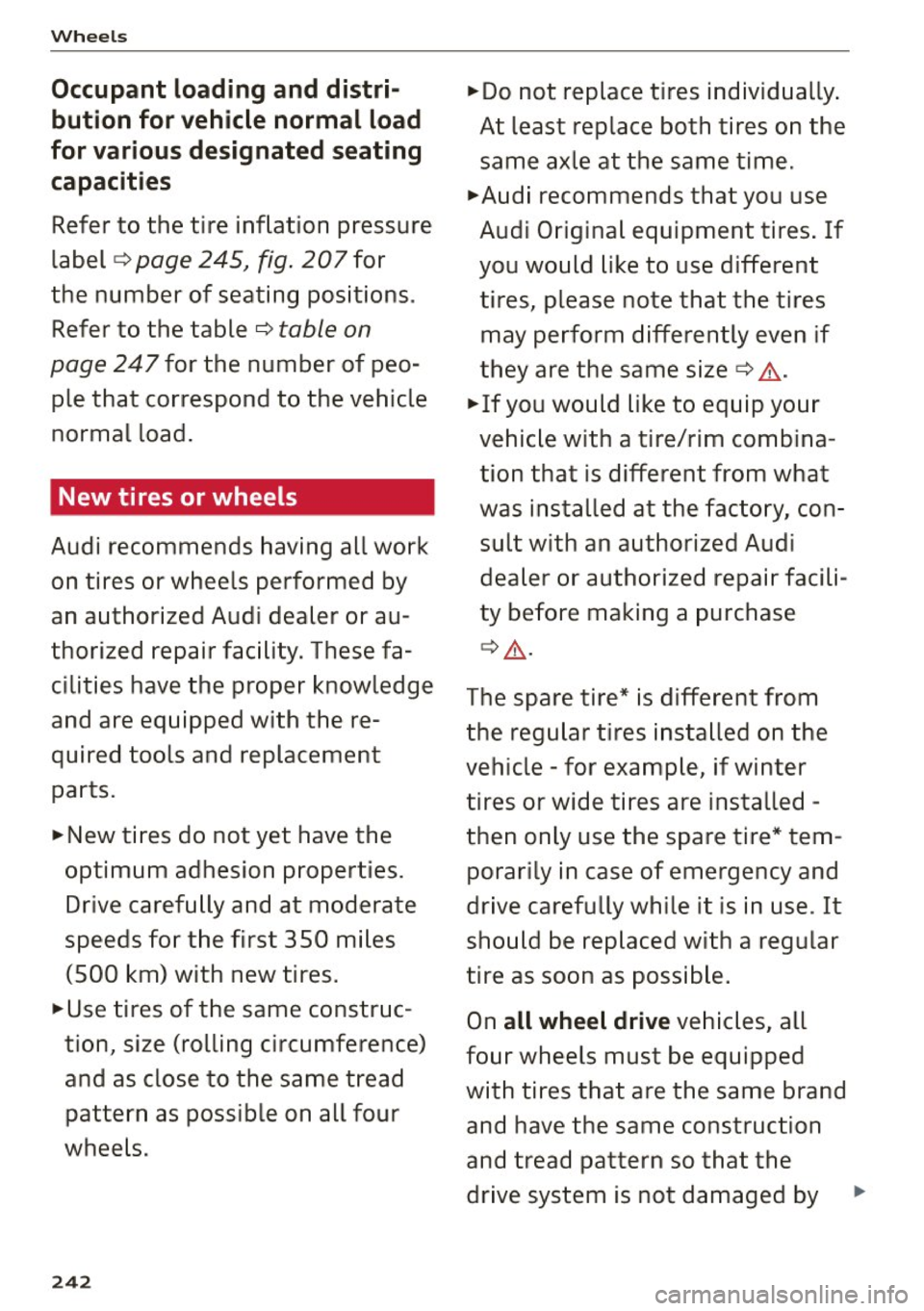
Wheels
Occupant loading and distri
bution for veh icle normal load
for various designated seat ing
capacit ies
Refer to the tire inflation pressure
label
c:> page 245, fig . 207 for
the number of seating positions .
Refer to the table
c:> table on
page
247for the number of peo
ple that correspond to the vehicle
normal load .
New tires or wheels
Audi recommends having all wo rk
on tires or wheels performed by
an authorized Audi dea ler or au
thorized repair fac ility. These fa
cilities have the proper knowledge
and are equipped with the re
quired tools and replacement
parts.
.,. New tires do not yet have the
optimum adhesion properties. Drive carefully and at moderate
speeds fo r the first 350 miles
(500 km) with new tires .
.,. Use tires of t he same constr uc
tion, size (rolling c ircumference)
and as close to the same tread pattern as possible on all four
wheels.
2 4 2
.,.Do not replace tires individ ually .
At least re place both t ires on the
same axle at the same time.
.,. A udi recommends that you use
Aud i O riginal equipment tires . If
you wo uld li ke to use different
tires, please note that the tires may perform d ifferently even if
they are the same s ize
c:> &. -
.,. If you would like to equip you r
vehic le with a tire/rim combina
tion that is different from what
was installed at the facto ry, con
sult w ith an authorized Aud i
dealer or authorized repair facili
ty be fore making a purchase
¢ .&_ .
The spare tire* is d ifferent from
the regular t ires installed on the
vehicle -for example, if winter
tires or wi de tires are installed -
then only use the spare tire* tem
porar ily in case of emergency and
drive carefully while it is in use . It
s h o u ld be replaced w ith a regular
tire as soon as poss ib le.
On
all wheel drive ve hic les, all
four wheels must be equipped
w ith tires that are the same brand
and have the same construction
and tread pattern so that the
drive system is not damaged by
Page 245 of 302
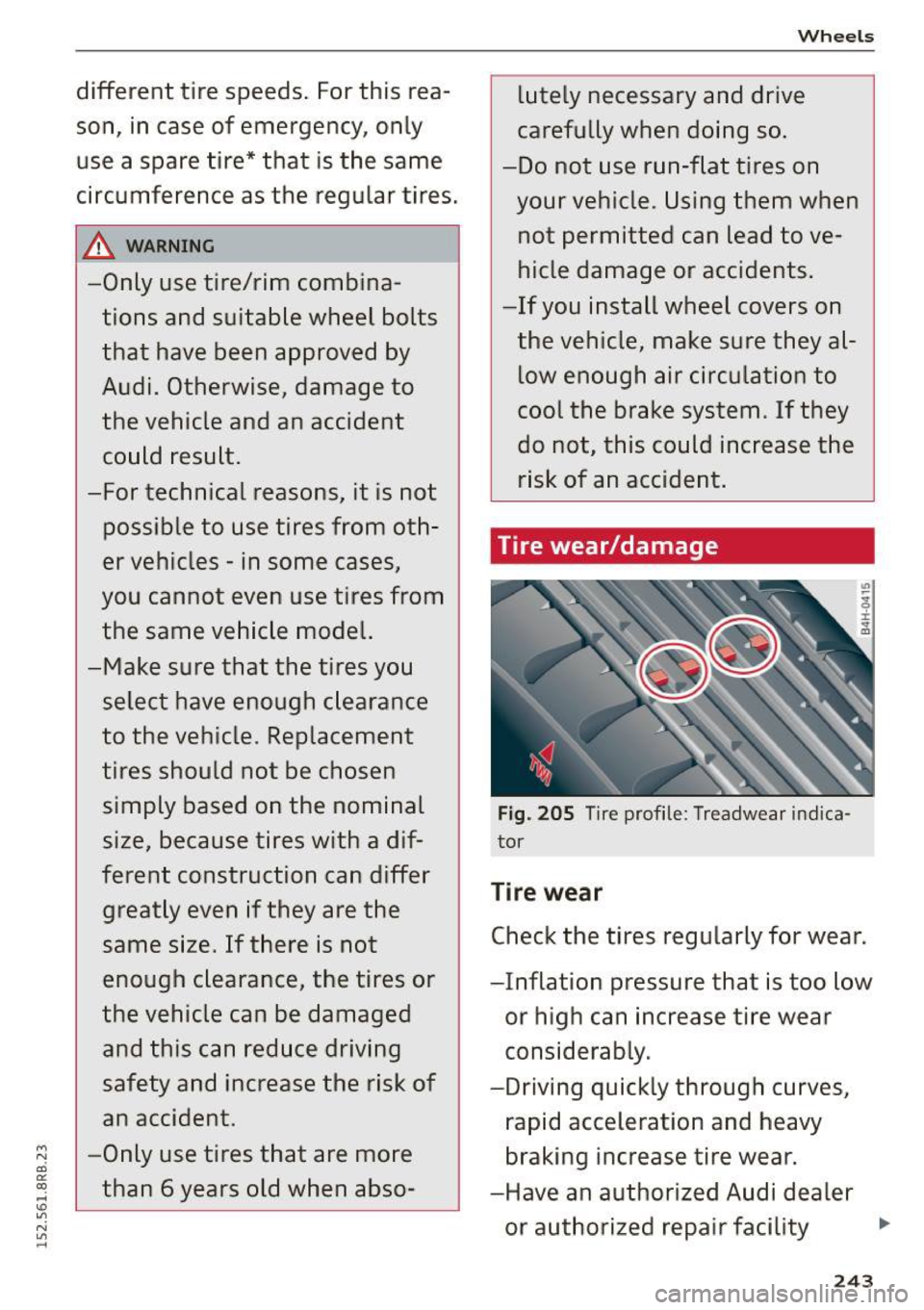
M N ai
"' ~
-"' "' N
"' .....
different tire speeds. For this rea
son, in case of emergency, only
use a spare tire* that is the same
circumference as the regular tires.
A WARNING -
-Only use tire/rim combina
tions and suitable wheel bolts
that have been approved by
Audi. Otherwise, damage to
the vehicle and an accident
could result.
-For technical reasons, it is not possible to use tires from oth
er vehicles - in some cases,
you cannot even use tires from
the same vehicle model.
-Make sure that the tires you select have enough clearance
to the vehicle . Replacement
tires should not be chosen
simply based on the nominal
size, because tires with a dif
ferent construction can differ greatly even if they are the
same size. If there is not
enough clearance, the tires or
the vehicle can be damaged
and this can reduce driving
safety and increase the risk of
an accident.
-Only use tires that are more
than 6 years old when abso-
Wheels
lutely necessary and drive
carefully when doing so.
-Do not use run-flat tires on your vehicle . Using them when
not permitted can lead to ve
hicle damage or accidents.
-If you install wheel covers on
the vehicle, make sure they al low enough air circulation to
cool the brake system. If they
do not, this could increase the
risk of an accident.
Tire wear/damage
Fig. 205 Tir e profi le : Treadwear indica
tor
Tire wear
Check the tires regularly for wear.
-Inflation pressure that is too low
or high can increase tire wear
considerably .
-Driving quickly through curves,
rapid acceleration and heavy
braking increase tire wear.
-Have an authorized Audi dealer or authorized repair facility
243
...
Page 251 of 302

M N
co
a:
co
,...., \!) 1.1'1
N 1.1'1 ,....,
Determining correct load
limit
Use the example below to calcu
late the total weight of the pas
sengers and luggage or other
things that you plan to transport
so that you can ma ke sure that
your vehicle will not be overload ed .
Steps for Determining Correct
Load Limit
1 . Locate the statement "THE
COMBINED WEIGHT OF OCCU PANTS AND CARGO SHOULD
NEVER EXCEED XXX KG OR XXX
LBS"on your vehi cle's pla card
(tire inflation pressure label)
¢ page 245 , fig. 206.
2 . Determine the combined
weight of the driver and pas
sengers that will be riding in
your vehicle.
3 . Subtract the combined weight
of the driver and passengers
from
"XXX " kilograms or "XXX"
pound s shown on the sticker
¢ page 245 , fig. 206 .
4. The resulting figure equals the
available amount of cargo and luggage load capacity. For ex
ample, if the
" XXX" amount
equals 1400 lbs. and there will
Wheels
be five 1 SO lb s. passenger s in
your vehicle, the amount of available cargo and luggage load capa city is 650 lb s.
(1400-750 (5 X 150) = 650
lb s.)
5. Determine the combined
weight of luggage and cargo
being loaded on the vehicle .
That weight may not safely e x
c eed the available cargo and
luggage load capa city cal culat
ed in Step 4 .
6. If your vehicle will be towing a trailer, load from your trailer
will be transferred to your vehi
cle. Con sult thi s manual to d e
termine how this redu ce s the
available cargo and luggage load capacity of your vehicle .
.,.Check the tire sidewall
(¢ page 235 , fig. 204) to deter
mine the designated load rating
for a specific tire.
Wheel bolts and rims
Wheel bolts
W heel bolts mus t be clean and loose n/tighten
easily .
Rims
Rims with a bo lted r im ring* or with bo lt ed wheel
cove rs* cons ist of multi ple p ieces . These compo
nents were bolted together using specia l bolts
and a spec ia l procedu re . You must not repa ir or
disassemb le th em
i::> Li::,. . ..,.
249
Page 253 of 302
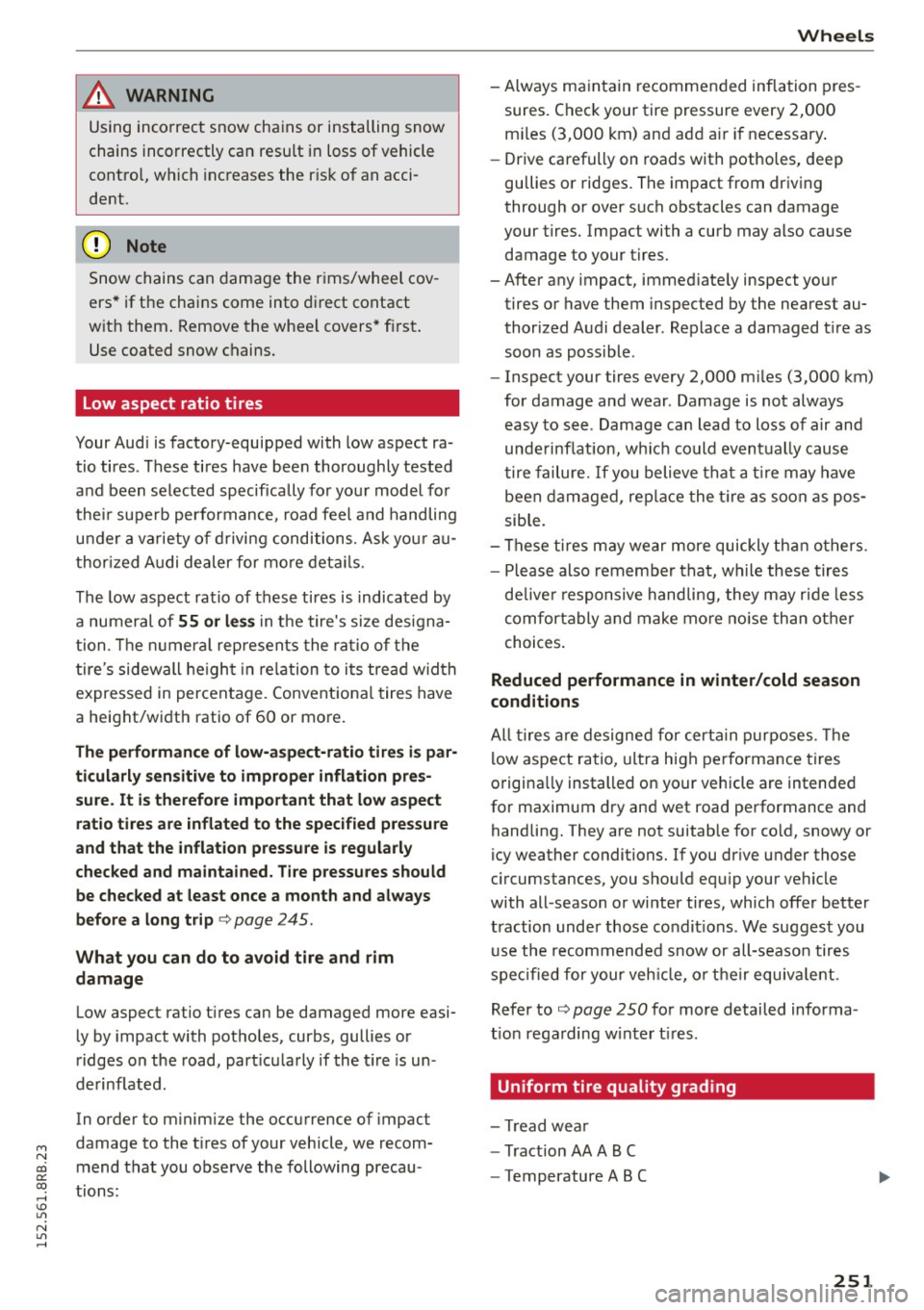
M N
co
a:
co
,...., \!) 1.1'1
N 1.1'1 ,....,
& WARNING
Using incorrect snow chains or installing snow
chains incorrectly can result i n loss of vehicle
contro l, wh ich inc reases the r is k of an acci
dent.
(D Note
Snow chains can dama ge the r ims/wheel cov
ers * if t he chains come into d irect contact
w it h them . Remove the whee l covers * fir st .
Use coated snow chains.
Low aspect ratio tires
Your Audi is factory-equipped with low aspect ra
tio tires . These tires have bee n thoroughly tested
and been selected specifically fo r yo ur model fo r
the ir supe rb pe rformance, road feel and handling
u nder a va riety o f drivi ng conditions. Ask yo ur au
thor ized Audi de aler for mo re det ail s.
The low aspect ratio of these tires is indica ted by
a numeral of
55 or less i n t he tire's si ze des igna
tion . Th e nu mera l represents the rat io of the
tire's sidewall he igh t in relation to i ts tre ad wid th
expressed in percentage. Convent iona l tires have
a height/wi dth ratio of 6 0 or mo re .
The performan ce of low-a spe ct-rati o tires i s par
ticularly sensitive to improper inflation pre s
sure . It is therefore important that low a spect
ratio tires are inflated to the specified p ressure
and that the inflation pressure is regularly
checked and maintained. Ti re pressures should
be checked at least once a month and always
before a long trip
c:> page 245.
What you can do to avoid tire and rim damage
Low aspect ratio t ires can be damaged more easi
ly by impact with potholes, curbs , gullies or
ridges on the road , par ticu la rly if the t ire is un
de rinflate d.
In order to m inim ize the occurrence of impact
damage to the t ires of your vehicle, we recom
mend that you observe the following precau
tions:
Wheels
- Always ma inta in recommended inflation pres
sures. Chec k your tire pressure every 2,000
m iles (3,000 km) and add a ir if necessa ry .
- Drive carefully on roads with potholes, deep
gu llies o r ridges. T he impact from dr iving
through or over such obstacles can damage
your tires. Impact with a curb may also cause damage to your tires.
-After any impact, immed iate ly inspect your
tires or have them inspected by the nearest au
thorized Audi dealer . Replace a damaged t ire as
soon as poss ible .
- Inspect your tires every 2,000 m iles (3,000 km)
for damage and wear. Damage is no t always
easy to see . Damage can lead to loss o f air and
un derinflation, wh ic h could even tually caus e
t ire failure. If you believe tha t a tir e may have
been dam age d, rep lace the t ire as soon as pos
sible.
- These ti res may wear more quickly tha n oth ers.
- Please also remember that, wh ile these tir es
delive r respo nsive handling, they may ride less
c omfortably and m ake mo re no ise th an ot her
choices .
Reduced performance in winter/cold season
conditions
All tires a re designe d for cer ta in p urpo ses. The
l ow as pect ra tio, ultra high pe rformance tires
o rigi na lly installed on your vehicle are intende d
for maximum d ry and wet road performance and
handling. They are not suitab le f or co ld, snowy or
icy weather conditions. If you dr ive under those
c ircumstances, you shou ld equ ip your vehicle
with all-season or winter tires, wh ich offe r better
t raction unde r those co ndit ions . We suggest you
u se the recommende d snow or all-season tires
spe cified for your veh icle, o r th eir equiva le nt.
Refer to
c:> page 250 for more detailed informa
t io n regarding w in te r tir es.
Uniform tire quality grading
- Tread wea r
- Traction AA A B C
- Temperature ABC
251
Page 254 of 302

Wheels
Quality grades can be found where applicable on
the tire side wall between t read sho ulder and
maximum sect ion w idth
c::> page 235, fig . 204.
For example: Tr ead wear 200 , Tract ion AA, Tem
peratu re
A .
All passenger ca r tires must confo rm to Federal
Safety Req uiremen ts in add it ion to these grades.
Tread wear
The tread wear grade is a comparative rating
based on the wear rate of the tire when tested
unde r controlled conditions on a spec ified gov
ernment test course.
For examp le, a t ire graded 150 would wear one
and one half ( 1 1/2) t imes as well on the govern
ment course as a tire graded 100 .
The relat ive performance of t ires depends upon
the actua l conditions of their use, however, and
may depart significantly from the norm due to
variations i n driving hab its, service practices and
d iffe rences in road character istics and clima te.
Traction
The traction grades, from highest to lowest, are
AA, A , Band
C. Those grades represent the tire's
ab ility to stop on wet pavement as measu red u n
de r controlled cond it ions on spec ified govern
ment test su rfaces of asphalt and concrete. A tire
marked C may have poor traction performance
c::> &_ .
Temperature
The temperature grades are A (the highest), B,
a nd C, rep resent ing t he tire's res istance to the
genera tion of heat and its a bility to dis sipate
heat w hen tested unde r controlled cond itions on
a specified indoo r laboratory test whee l.
Sustained high temperature can cause the mate rial of the tire to degenerate and red uce tire life,
a nd excessive tempera ture can lead to sudden
tire failure
c::> &. .
The grade C co rresponds to a level of perform
ance wh ich a ll passenge r ca r tires m ust meet un
de r th e Federal Motor Vehicle Safety S tandard
No. 109. G rades Band A represent higher levels
252
of pe rformance on the laboratory test whee l than
the minimum required by law .
A WARNING -
The traction grade assigned to th is tire is
based on straight-ahead braking tract ion
tests, and does not include acce lerat ion, cor
nering, hyd roplaning or peak traction charac
teristics.
A WARNING
The temperature g rade for th is tire is estab
lished for a tire that is properly inf lated and
n ot ove rloaded. Excess ive speed, underi nfla
tion, o r ex cess ive lo adi ng, eithe r separately or
i n comb inat io n, can ca use heat bu ild up and
possible tire failure.
A WARNING
Tempe ratu re grades apply to ti res that are
properly inflated and not over or underinflat
ed.
Tire pressure monitoring system
(l) General notes
App lies to vehicl es: wi th tire p ress ure mo nito rin g system
-
Each tire, incl uding the spare (if provided),
sho uld be checked monthly when co ld and inflat
ed to the inflat ion pressure recommended by the
vehicle manufacturer on the vehicle placard or
tire inflat ion pressure label. (If your vehicle has
tires of a different s ize than the size indicated on
the ve hicle placard or t ire inflation pressu re la
bel, you should dete rm ine the p roper t ire infla
tion pressu re for those t ires).
As a n added safety feature, your ve hicle has been
equipped with a tire pressure mon itor ing system
( TP MS) that illum inates a low t ire pressure te ll-
ta le w hen o ne or mo re of yo ur ti res is sign ificant -
l y unde r-i nflated. According ly, w hen t he low t ire
pressure te lltale illuminates, you shou ld stop and
check yo ur tires as soon as possible, and inflate
them to the proper pressure . Dr iving on a signifi
cant ly under-inf lated tire causes the t ire to over
heat and can lead to tire failure. Under-inflation .,,.
Page 255 of 302

M N
co
a:
co
,...., \!) ..,.,
N ..,., ,....,
also reduces fuel efficiency and tire tread life,
and may affect the vehicle's handling and stop
ping ability .
Please note that the TPMS is not a substitute for
proper tire maintenance, and it is the driver's re
sponsibility to maintain correct tire pressure,
even if under-inflation has not reached the level
to trigger illumination of the TPMS low tire pres
sure telltale.
Your vehicle has also been equipped with a TPMS malfunction indicator to indicate when the sys
tem is not operating properly. The TPMS mal
function indicator is combined with the low tire pressure telltale . When the system detects a
malfunct ion, the telltale will flash for approxi
mately one minute and then remain continuously
illuminated. This sequence will continue upon
subsequent veh icle start-ups as long as the mal
function exists.
When the malfunction indicator is illuminated,
the system may not be able to detect or signal
low tire pressure as intended. TPMS malfunctions
may occur for a variety of reasons, including the
installation of replacement or alternate tires or
wheels on the vehicle that prevent the TPMS
from functioning properly. Always check the
TPMS malfunction telltale after replacing one or more tires or wheels on your vehicle to ensure
that the replacement or alternate tires and
wheels allow the TPMS to continue to function properly.
Wheels
If the Tire Pressure Monitoring System
indicator appears
Appl ies to vehicles : wi th t ir e p ress ure mo nito rin g system
The tire pressure indicator in the instrument
cluster informs you if the tire pressure is too low
or if there is a system malfunction.
Fig. 208 Instrument cluster: i ndicator light with message
Using the ABS sensors, the tire pressure monitor
ing system compares the tire tread circumference
and vibration characteristics of the individual
tires .
If the pressure changes in one or more
tires, this is indicated in the instrument cluster
display with an indicator light
RIJ and a message
¢fig. 208. If only one tire is affected, the loca
tion of that tire will be indicated.
The tire pressures must be stored in the Infotain
ment system again each time the pressures
change (switching between partial and full load
pressure) or after changing or replacing a tire on
your vehicle ¢
page 254. The tire pressure moni
toring system only monitors the tire pressure you have stored. Refer to the tire pressure label for
the recommended tire pressure for your vehicle
¢ page 245, fig . 207.
Tire tread circumference and vibration character
istics can change and cause a tire pressure warn
ing if:
- the tire pressure in one or more tires is too low .
- the tire has structural damage.
- the tir e was replaced or the tire pressure
changed and it was not stored again
c:!;> page 254.
-the collapsible spare* tire is installed.
253